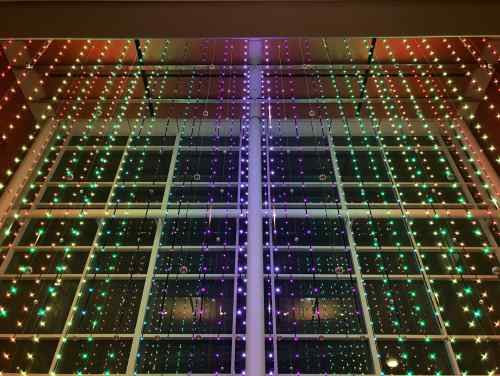Radiant Echo Unveiled in McLain Atrium
For a brief time, Washington College was the center of American pryotechnics. A new art installation in the Toll Science Center, Radiant Echo, honors the two WC professors and alumni who made it so.

CHESTERTOWN, MD—Radiant Echo, an illuminated, choreographed sculpture installation honoring two Washington College alumni and chemistry professors who have had a major impact on the teaching, technology, and field of fireworks, will be unveiled on Oct. 5.
The public is invited to attend the event, which begins at 7:30 p.m. Bring a blanket or lawn chair to the lawn outside of the McLain Atrium of the Toll Science Center for a “fireworks” show unlike any other.
Created by Flux Studio of Baltimore, Radiant Echo honors the work and legacies of Joseph H. McLain '37 and John A. Conkling '65, whose contributions to the College and the fireworks industry over 70-plus years have been innovative and far-reaching. It will be dedicated to the memory McLain and his wife, Ann H. McLain '40, and in honor of Conkling and his wife, Sandy Conkling '65.
McLain, who held the W. Alton Jones Chair in Chemistry and went on to become the College's president from 1973 to 1981, helped develop rocket propellant formulas and pyrotechnic actuation devices used for stage separations in space flights, and eventually would hold more than 30 patents—including several for smoke grenades used by the Army to camouflage movements of advancing troops. He also wrote textbooks in the field of solid-state chemistry, publishing “Effect of Phase Change in Solid-State Reactions” (Department of the Army, 1966) and “Pyrotechnics from the Viewpoint of Solid State Chemistry” (Franklin Institute Press, 1980). Among other industry affiliations and service, he was the founding member of the National Council on Fireworks Safety in 1979.
Conkling, Emeritus Professor of Chemistry, began his career as McLain's student and returned to Washington College after graduate school to eventually become one of the world's foremost experts in pyrotechnics. The holder of eight patents, he authored the seminal text “Chemistry of Pyrotechnics: Basic Principles and Theory” (CRC Press, 1985, 2011, 2019) and “Boom! America's Ever-Evolving Fireworks Industry” (Whitman Publishing, 2017). He is routinely in demand by the media worldwide to discuss all aspects of fireworks, their history, and their future. Involved in the leadership of the American Pyrotechnics Association (APA) since 1972 (at McLain's urging), Conkling became the APA's executive director and technical director.
Installed in the three-story McLain Atrium of the Toll Science Center, Radiant Echo is 27 feet long from top to bottom and 31 feet wide. Comprised of 78 strands suspended from aluminum channels at the atrium ceiling, the artwork features 286 reflective orbs and 3,640 programmable LED lights that display a series of dynamic sequences. In the words of Flux Studio founder Glenn Shrum, it “evokes the powerful and enigmatic nature of fireworks through its default resting state and the five distinct active states.” The installation is programmed to cycle through its various states in randomized order. Active states include “axial shimmer,” described as “glittering columns and [a] prismatic array of colors [that] respond to prominent architectural features” in the atrium, and “exploding stars,” which has “a color palate that references metallic salts commonly used in the production of [fireworks] stars … this show follows the process of [fireworks'] explosion from lift to ignition to burst.”
After installation, faculty will be able to use the sculpture to illustrate principles of physics, chemistry, psychology, computer programming, and art.
Radiant Echo began as a project of Sandbox, which was supported by a grant from The Andrew W. Mellon Foundation. It was funded by private donations from WC alumni and friends of the McLain and Conkling families.